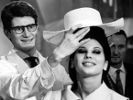Eye For Film >> Movies >> L'Amour Fou (2010) Film Review
L'Amour Fou
Reviewed by: Anne-Katrin Titze

When people are comfortable in their clothes, it makes them happy.
Yves Saint Laurent transformed how women dress. Pierre Thoretton's elegant documentary begins at a press conference in Paris in 2002, where the Algerian-born French designer announced his retirement, talking about his innovation of the tuxedo and the trench coat, changes in French haute-couture and prêt-à-porter, mental hospitals, Proust, depression, false friendships and Rimbaud.

His goodbye to the fashion world shows him as an eclectic, sparkling, opaque, troubled and completely irresistible man. A fashion of mourning.
"If Chanel gave women freedom during the first half of the 20th century, Saint Laurent gave them power", says Pierre Bergé, YSL's partner in business and life for 50 years, who guides us through this documentary about art and fashion, between people and things.
YSL knows that "the most important encounter is with oneself" and reminds us that the main accomplishment of his clothes for women is "to reassure them."
L'Amour Fou transitions to two funerals for the most influential fashion houses in Paris.
YSL's own in 2008, then Christian Dior's in 1957, whose assistant Saint Laurent was at age 18, and whom he replaced as head designer of the couture house of Dior at 21.
Like Matt Tyrnauer's film Valentino: The Last Emperor (2008) about haute-couture designer Valentino Garavani and his business partner Giancarlo Giammetti, L'Amour Fou is as much about a love and business relationship in the fashion industry as it is about clothes, houses, and art. The perspective we get a glimpse from is different, of course. Unlike Valentino, who is very much alive, YSL is the object of mourning. L'Amour Fou chronicles how Bergé and YSL founded their own couture house, bought their first work of art together, (a Syrian bird statue in 1960) and staged their first prêt-à-porter collection in 1962. At the time of YSL's famous Fall 1965 Mondrian collection, they could never have imagined that one day they would actually own a painting by Mondrian.
"Objects don't have a soul," Bergé says at one point, sitting in the apartment on rue de Babylone, in Paris, among antiques and works by Picasso, Matisse, Braque and Brancusi. The artworks we soon see dismantled in front of our eyes by experts to be auctioned off by Christie's, in what became known as "the auction of the century" for Aids research. And strangely enough, though the film takes its time to guide us through the couple's fantastically beautiful villas in Marrakhesh, the red city, (the yellowest of yellows) and Normandy (where the rooms have Proustian names), he is right. Instead of inviting us to fetishise the art and exquisite furniture, we miss the man who lived in these rooms, often troubled by severe depression and hiding from the world.
Our view, through Bergé's eyes, is that of the melancholic, someone who has the object of desire but has lost the object-cause of desire. YSL, Bergé states, had he survived him, would have never sold their collection.
Director Thoretton intersperses well-selected archival footage and interviews with friends Loulou De La Falaise and Betty Catroux. We find out why brides are boring and Linda Evangelista's Opium ad is not, why body hair on a man shouldn't be underestimated, and why being silly or a sage is an important decision for someone who was never young. We see YSL play with Mick Jagger and Diana Vreeland and find out what he thought about Andy Warhol's decision to portrait him without glasses.
Bergé narrates like a story-teller the time YSL discovered drugs and alcohol and how he gave it all up to become more and more of a recluse who was happy only twice a year, when taking his bow after the spring and fall collections.
The footage we see of the galas, the social events, the mingling, the false smiles and embraces, surrounding the Christie's auction would have been a pure nightmare for YSL, everything Bergé described him hiding from.
"I don't believe in a soul," says Bergé, while the experts, the "undertakers of art" are dismantling the Brancusi in the Paris apartment. Still, he wishes for a good new life for the artworks, "like birds finding a new perch."
Reviewed on: 23 Nov 2012
















